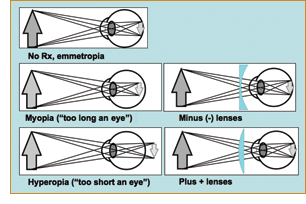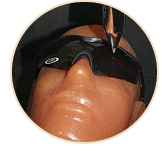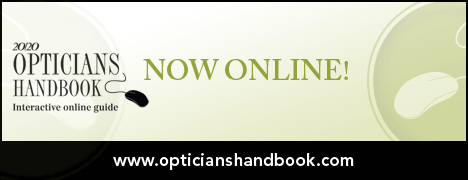|
Your monthly guide to staff training outside the box
Eyes / Lenses / Fitting Lenses / Free-Form / Frames / Sunwear / Patient Solutions / In-office / Standards
THE EYES
EYE DEVELOPMENT
By Linda Conlin, BS, ABOC, NCLEC
Eye development during the first trimester of pregnancy is like watching the grand finale of Fourth of July fireworks. Cells and tissue develop quickly and simultaneously to form various eye structures. For example, as the lens is developing, the cornea forms from ectoderm cells covering the lens. At about five weeks of pregnancy, this tissue is two cells thick. What occurs over the next two weeks is amazing. The number of ectoderm cells will nearly double, creating the corneal epithelium.
See Plus »
|

Cross-section of embryonic human eye at eight weeks gestation. Pink area is the corneal epithelium, and blue is the inner layers.
|
20/20: WHAT DO THE NUMBERS MEAN?
THE NUMERATOR AND THE DENOMINATOR—AN EXPLANATION
By Barry Santini, ABOM
At first sight, the term 20/20 appears so familiar to much of the public that vision professionals sometimes underappreciate how little people really understand about what the fraction is meant to convey.
The upper number, the numerator, represents the distance at which the subject can just discern the line of letters or images (optotypes) being tested. The bottom number, the denominator, represents the distance at which a "normal" sighted person would stand to see the same line of optotypes. Although in the U.S. we use feet as the unit of distance measurement, meters could be substituted easily in the same fractional notation.
See Plus »
|
|


|
WHO WEARS WHAT KIND OF LENSES?
If the patient has no refractive error or does not need glasses, refractive condition is called emmetropia or normal vision. If the Rx is minus, the patient is myopic (nearsighted), the image is focused in front of the retina and requires minus lenses to move the image backwards onto the retina.
See Plus »
|

|
STRABISMUS: THE INSIDE STORY
By Johnna Dukes, ABOC, FNAO
The definitions of strabismus are wide and varied. It's specifically defined as "a vision condition in which a person can not simultaneously align both eyes under normal conditions," and in general as "any misalignment of the eyes."
Even though the definitions are wide and varied, one common thread can be found between all of them. Strabismus is a condition of the eyes commonly characterized by "turning" or "crossing" of one or both eyes.
If you think of the eyes as headlights on a car driving at night, both of the headlights should shine together on the road ahead. If one of the lights were not working or pointing in a different direction, would you as the driver (the brain) be able to see the road properly? Not likely since the two eyes working in cooperation produce a well-functioning visual system and achieve proper stereopsis (or three-dimensional vision).
|
Going Ballistic Over Sunwear, Daily!
How Getting ANSI Makes Sense

According to Prevent Blindness America (PBA), more than 850,000 Americans injure their eyes annually during home and work activities or while playing sports. Yet experts say wearing safety glasses and taking other common-sense precautions can prevent or reduce the severity of most eye injuries. (Adapted from allaboutvision.com)
It's easy to overlook outdoor eye safety since it's inconvenient to stop what you're doing and put on a pair of safety glasses, especially if they're ugly and industrial. But think about the alternative—partial vision from an injury to one or both eyes. Objects can be moving at high speed—up to 150 feet per second and with such energy it can do irreversible damage. It may change your life because it changes your ability to do the normal everyday things that you do now—driving, cycling, working, reading, writing, traveling, etc. It's time to go ballistic over sunwear—safety sunwear that is.
See Plus »
|
WHAT'S THE PROBLEM WITH UV AND HEV RADIATION?
By John Lahr, OD, and Mark Mattison-Shupnick, ABOM
 The National Institute of Heath estimates that the incidence of conditions like cataract, diabetic retinopathy, AMD and glaucoma will increase by the year 2020. In fact it is estimated that more than 45 million Americans age 40 and over will be blind or visually impaired from AMD, glaucoma, diabetic retinopathy or cataracts. What does the sun have to do with it?
The National Institute of Heath estimates that the incidence of conditions like cataract, diabetic retinopathy, AMD and glaucoma will increase by the year 2020. In fact it is estimated that more than 45 million Americans age 40 and over will be blind or visually impaired from AMD, glaucoma, diabetic retinopathy or cataracts. What does the sun have to do with it?
UV RADIATION: The cumulative effects of ultraviolet radiation (UVR) have been implicated as a cause of cataracts, keratitis, pingueculae, pterygia, various eye and skin cancers, wrinkles, as well as age-related macular degeneration.
HEV RADIATION: High Energy Visible light (HEV), the wavelengths between 380 and 500 nm (blue light) have been implicated as a contributing cause of age-related macular degeneration. Why is this a problem? Blue light is part of the spectrum of colors we "see" every day. Its accumulation affects the cone's ability to process light leading to possible oxidative damage, which can be irreversible in the retina.
See Plus »
|
Viewpoint
PRESCRIBE, OUTDOOR EYEWEAR'S CALL TO ACTION
In the exam room: "The solution—one that will provide your patient with superior vision and you with a healthier bottom line—is to prescribe chairside. Make a strong and clear brand specific recommendation to the patient, and have your optician and ancillary staff reinforce that message when the patient moves to the dispensary." ("Dispensing the Best Lenses Begins in the Exam Room," Mark Wright, OD)
In this case, the reason to prescribe chairside is a preventive one. Especially if there are no conditions that suggest UV and HEV damage. Today's consumer is very receptive to preventing future events that compromise health. Examples are of course, baby aspirin (heart attacks), dental cleanings (abscess, cavities), sunscreen (sunburn, melanoma), etc. As a result, open with a statement like: "I'd like to spend some time continuing the discussion about the need for outdoor eyewear/sunglasses. My staff (or name of staff member) first mentioned the need for sunwear when you checked in for this appointment." Many doctors are averse to product discussions but the contemporary consumer looks to the professional for a personalized, individual advice.
From a Jobson Optical Insight survey: "Patients consider a doctor's product recommendation as one of the most important discussions during a comprehensive exam. In fact, patients receiving a product recommendation are more likely to recommend their eye doctor to friends and relatives." (March 2009, 198 patients surveyed)
—John Lahr, OD, and Mark Mattison-Shupnick, ABOM
See Plus »
|
|


|
|